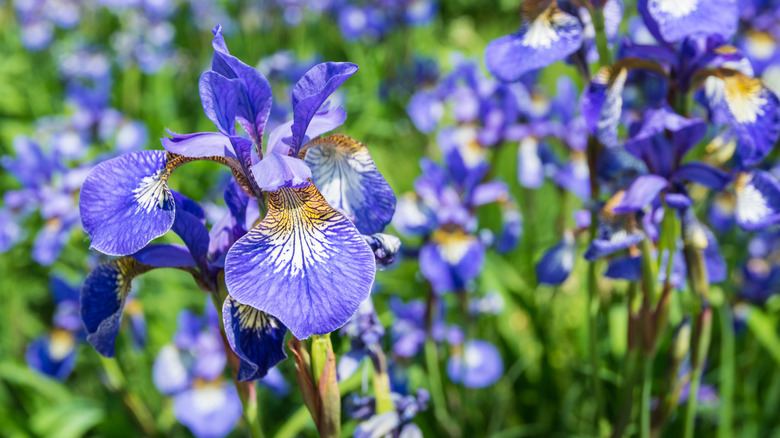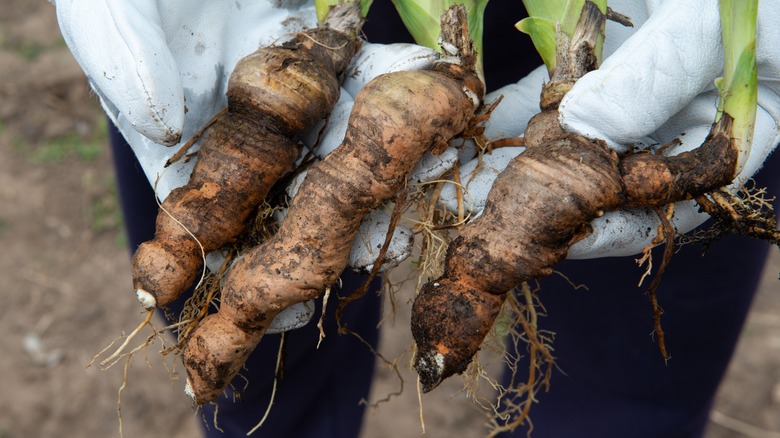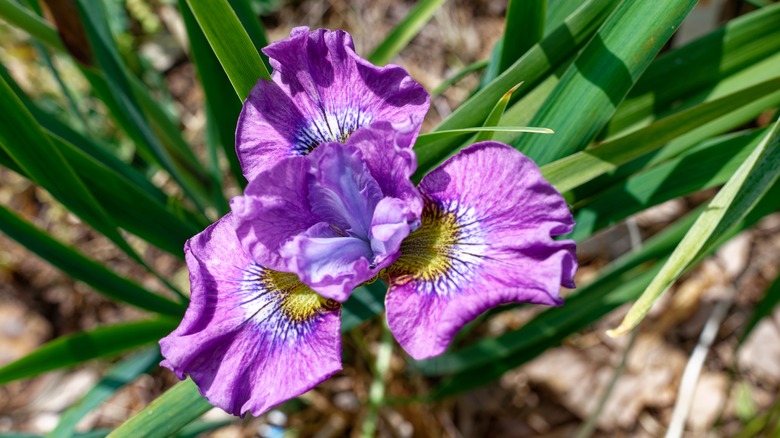Spring Is The Perfect Time To Plant This Reliable And Colorful Garden Bulb
Siberian irises (Iris sibirica) are hardy, easy-to-grow flowers native to Central and Eastern Europe. Among the 200 species of iris, Siberian irises are perhaps less common, but don't overlook these charming herbaceous perennials. They bloom colorful, 2.5-inch flowers from May to June and are less prone to disease than other irises. Siberian irises are clump-forming, reaching up to 2 feet tall and bearing 12 to 20 flowers per clump. Unlike many other iris species, Siberian irises can be planted in spring in climates with cool winters.
Irises can be bearded or non-bearded, with both types bearing flowers characterized by three upright petals and three drooping sepals called falls. Bearded irises have characteristic fuzzy, hair-like structures on the falls, resembling a beard. Siberian irises, however, are non-bearded. These flowers are slightly less showy than bearded irises and offer a more discrete option. Siberian iris flowers are typically shades of blue and violet, but there are white, orange, pink, red, and yellow varieties.
How to plant Siberian irises
Siberian irises grow from modified, underground stems called rhizomes. When planted, these rhizomes will grow into new plants. Note that some iris species grow from bulbs. Siberian iris rhizomes are most commonly planted in late spring or early summer in USDA zones 3 to 9. In regions with mild winters, Siberian irises can be planted in the fall. Consider that in USDA hardiness zones above 8b, hot summers may hinder the flowering of this species. Siberian irises are moisture-loving plants, preferring evenly moist soil that is well-draining. Choose a spot that receives full or partial sun.
Soak the rhizomes overnight to prepare for planting. Dig a hole and build a small mound in the center. Lay the rhizome on top of the mound, letting the roots lay down the sides. Fill in the hole so the rhizome is about 2 to 3 inches below the surface. Space planting holes 18 to 24 inches apart. To create full, attractive clumps, consider planting a few rhizomes together. Water well and maintain moisture until the plants are well established. Apply a low-nitrogen fertilizer around the base of the plant after planting and again each spring. Siberian irises are unlikely to bloom in the first year of planting. To encourage flowering year after year, divide and transplant established Siberian iris clumps in the fall.
Beautiful Siberian iris varieties
There are many Siberian iris cultivars to choose from, offering different flower shapes, colors, and sizes. The cultivar "Strawberry Fair" features heavily ruffled sepals in shades of lavender to pink, with white and blue central markings. "Blueberry Fair" shares the same showy, frilled blossoms but in a vibrant blue-purple. Iris sibirica "Butter and Sugar" is a slightly shorter variety, with delicate cream to soft lemon-colored blooms. For ivory to pink Siberian irises, "Fond Kiss" is a great choice, while "Caesar's Brother" provides a slightly taller variety, reaching 3 to 4 feet in height.
Siberian irises look great planted in multiples or combined with other attractive perennials as part of a mixed display. When choosing companion plants, consider the care requirements of each species. Siberian irises do well with other moisture-loving plants such as common yarrow (Achillea millefolium), butterfly milkweed (Asclepias tuberosa), scarlett rosemallow (Hibiscus coccineus), clustered bellflower (Campanula glomerata), and red columbine (Aquilegia canadensis). The lush blooms of peony flowers also make a classic, complementary pairing for your Siberian irises.


